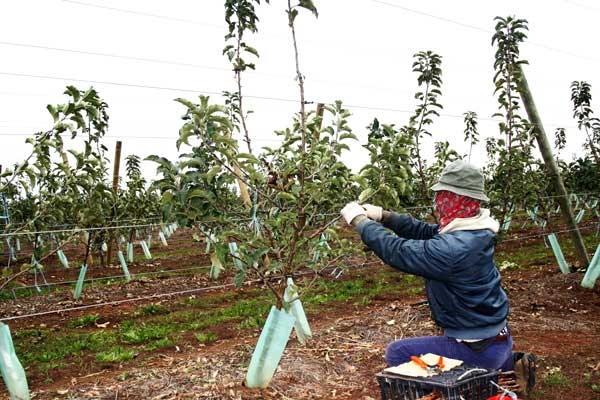In Australia, orchardists’ expectations of early tree growth are generally not high enough.
Too much sunlight, and therefore potential crop, is being wasted.
Cropping is directly linked to the amount of sunlight captured (intercepted) by fruit trees. The more light the trees capture, the more crop they can carry. Sunlight that hits the orchard floor is mostly wasted.
Apple orchard example
Using apple trees for example, most orchardists do not develop the canopy as quickly as they could.
Although trees are generally planted at the right density and on the right size-controlling rootstocks, insufficient early tree training means that the canopy is not developed as quickly as it should.
Pushing the young trees with water and nitrogen is not much good if you don’t guide the new growth towards filling the tree’s space.
This is done by summer pruning and tree training. The quicker you fill the tree’s space on a trellis, the more sunlight its canopy can capture and use the energy of this sunlight to produce fruit.
Highest possible light interception
The highest possible light interception for sustainable high yields of good quality fruit, is 70 per cent. This allows alley ways between rows for orchard equipment to pass through.
Most of the tree’s permanent structure should be established during the first three years.
Maximise early growth—don’t overcrop
To maximise early growth of the trees, they should not be cropped in the second and possibly also in the third year.
Cropping, and sometimes overcropping the trees in the third year, can severely set the trees back, especially when they are on M9 or M26 rootstock.
It will be difficult to invigorate young apple trees after they have been overcropped.
Vertical or angular canopies of apple trees that are thin and continuous, and have the correct height in relation to the width of the rows, should reach the 65 to 70 per cent light interception by year 6.
When that has been reached, accumulated yields of more than 230 tonnes per hectare have been recorded, with sustainable annual yields of between 65 and 90 tonnes per hectare of good quality fruit after year 6.
If your apple trees do not produce such yields and fruit quality, you should have a look at the architecture of your trees. Gaps in the canopy between trees is a waste of space—space that should be occupied with fruiting wood and apples, not fresh air.
See this article and all images in Tree Fruit March 2016






















